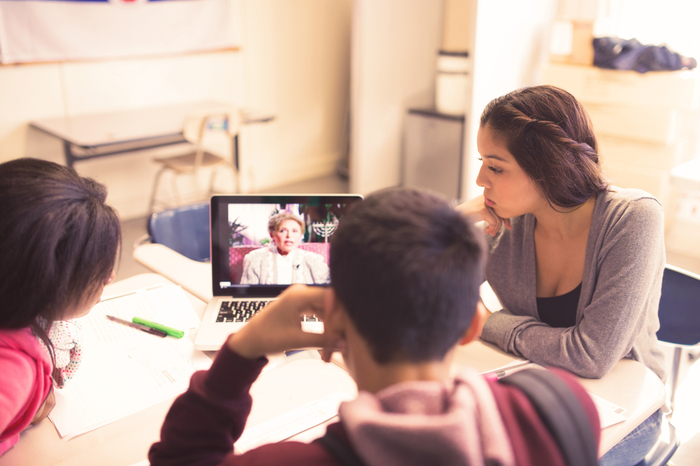
CLASSROOM LESSONS

After using Echoes and Reflections for many years with students, I was telling a friend of mine about a particular primary source from Lesson One: Studying the Holocaust that has always struck me. In it, the director of an orphanage describes his experience during Kristallnacht, the “Night of Broken Glass,” and the way he struggled to protect the kids under his care. As the night went on, children from all parts of the city came seeking safety until there were 90 with him being sheltered from the destruction happening around them.
My friend said that the story sounded incredibly familiar and I learned that her father was a child in that orphanage. He was there the night that Kristallnacht occurred. Her father survived because an American family adopted him just before emigration was no longer possible from Germany. This experience makes using these materials in my classroom even more meaningful.
Lesson One: Studying the Holocaust is one of my favorite sections of the Echoes and Reflections Teacher Resource Guide. I’ve used components of this lesson many times since I was first introduced to Echoes in 2005; first as part of a quarter-long “Introduction to the Holocaust” while teaching at a high school in Pennsylvania, and more recently, as part of a semester-long “Holocaust and Genocide” elective for eleventh and twelfth graders at Robert E. Lee High School in Staunton, Virginia. Although I use various aspects of Lesson One in other areas of my course, I love to share the components I use in my lesson on Kristallnacht with other teachers.
Kristallnacht is one of the most studied aspects of the Holocaust in American high schools. Nearly every American History textbook section that mentions the Holocaust makes note of this turning point on November 9-10, 1938. The “Night of the Broken Glass” was the first major public display of antisemitic violence against Jews in Germany and annexed Austria.
In talking about Kristallnacht, my class examines primary sources, like the one in which the orphanage director accounts his experiences. As we discuss these documents and photos I fill in other aspects of the history of Kristallnacht. I provide background, describe the unfolding of events on the night itself and we discuss the seizure of Jewish property that followed. Students are challenged to consider some of the most complex aspects of studying the Holocaust including, collaboration and complicity.
Following this document analysis, we then watch the testimony of Kurt Messerschmidt. Kurt was a young teacher at the time of Kristallnacht and his powerful description of events challenge my students to further consider what it means to be a bystander. His testimony is one of my favorites from the entire resource guide and I find that it also becomes a favorite of my students. I also make an effort to include the testimony of Esther Clifford, featured in Lesson Two: Antisemitism, at this point because her description of Kristallnacht adds another special layer.
I spend one ninety-minute block scheduled class on this material. In the days that follow I then introduce students to iWitness where their first task, is to take part in a lesson that I built specifically to examine a variety of experiences on Kristallnacht. As my students explore and respond to content in IWitness they gain an added dimension of understanding. They enjoy working with both the traditional resources and the new technology. I’ve been told that for many students, this one of their favorite lessons all semester.
Jennifer Goss is a Social Studies teacher at Robert E. Lee High School in Staunton, VA where she has taught since 2012. She currently teaches a Holocaust & Genocide elective in addition to Advanced Placement U.S. Government and Politics and US/VA History.

LITERATURE
TEACHING

Since 2009, I have been using Echoes and Reflections as an essential resource with English/language arts and history/social studies teachers to help their students understand the literature (fiction and non-fiction) of the Holocaust. Using the well-crafted lessons, powerful visual testimonies, and carefully selected primary documents in Echoes and Reflections, I help teachers learn compelling content and effective strategies that deepen students’ engagement and analysis of Holocaust literary and historical texts. By integrating these texts into Echoes and Reflections, teachers and students personalize the history of the Holocaust; reflect on the role of individual responsibility, and learn to act on behalf of social justice for all.
A lesson that I have found to be particularly effective is a lesson that I developed for use with in-service and preservice teachers using Lesson 4: The Ghettos and We Are Witnesses: Five Diaries of Teenagers Who Died in the Holocaust (Jacob Boas, Scholastic, 1995).
Below is an outline of the lesson “Integrating Holocaust Non-fiction into Echoes and Reflections.”
- Write the word “ghetto” on the board and ask students to write their images and thoughts about the word in a journal.
- Introduce Ellis Lewin and Joseph Morton to the group using their Biographical Profiles and then show their testimonies from Lesson 4. Have students compare their original images and thoughts about the word “ghetto” to what they learned from these survivors.
- Distribute primary source materials in Echoes and Reflections to enhance students’ understanding of the ghettos.
- After an introduction to the teenagers in We Are Witnesses, have students divide into groups by teenage author and then read about their chosen teenager as a group.
- Initiate a jigsaw exercise, asking students to move into new groups with at least one representative from each diary. Have students discuss their teenagers and perceptions of life in the ghettos.
- Share testimony from additional survivors featured in Lesson 4: Leo Berkenwald, Milton Belfer, George Shainfarber, and Eva Safferman to provide students with additional perspectives of ghetto life.
- Ask students to consider what they learned about the ghettos from the diary entries and visual history testimonies shown in class using the following questions to guide the discussion:
- What did the young people you learned about do to survive in the ghettos?
- How did the people you read about or listened to maintain hope?
Lesson 4: The Ghettos addresses Common Core State Standards and the NCTE/IRA Standards for the English Language Arts with its focus on citing textual evidence, analyzing multiple mediums, and referencing texts.
Beverly Ann Chin is Professor of English, Director of the English Teaching Program, and former Director of the Montana Writing Project at the University of Montana in Missoula.




This site contains links to other sites. Echoes & Reflections is not responsible for the privacy practices or the content of such Web sites. This privacy statement applies solely to information collected by echoesandreflections.org.
We do not use this tool to collect or store your personal information, and it cannot be used to identify who you are. You can use the Google Analytics Opt-Out Browser Add-on to disable tracking by Google Analytics.
We currently do not use technology that responds to do-not-track signals from your browser.
Users may opt-out of receiving future mailings; see the choice/opt-out section below.
We use an outside shipping company to ship orders. These companies are contractually prohibited from retaining, sharing, storing or using personally identifiable information for any secondary purposes.
We may partner with third parties to provide specific services. When a user signs up for these services, we will share names, or other contact information that is necessary for the third party to provide these services.
These parties are contractually prohibited from using personally identifiable information except for the purpose of providing these services.
1. You can unsubscribe or change your e-mail preferences online by following the link at the bottom of any e-mail you receive from Echoes & Reflections via HubSpot.
2. You can notify us by email at info@echoesandreflections.org of your desire to be removed from our e-mail list or contributor mailing list.






 English
English